Table of Contents
Introduction to Skydiving
Skydiving, often hailed as the ultimate adventure sport, is an exhilarating activity that involves jumping from an aircraft and free-falling through the sky before deploying a parachute to slow down and land safely on the ground. Originating as a military training exercise, skydiving has evolved into a popular recreational pursuit worldwide, offering adrenaline junkies an unmatched thrill.

Popular Skydiving Destinations
When it comes to skydiving, there are certain destinations that stand out for their stunning landscapes and ideal conditions for the sport. Places like Interlaken in Switzerland, Queenstown in New Zealand, and Dubai in the United Arab Emirates attract skydivers from all over the globe with their breathtaking views and top-notch facilities.
Factors to Consider Before Skydiving
Before embarking on a skydiving adventure, it’s essential to consider various factors to ensure a safe and enjoyable experience. Safety precautions such as checking weather conditions, verifying the credentials of the skydiving center, and undergoing proper training are paramount. Additionally, participants must meet certain health requirements to ensure they are physically capable of skydiving.
Different Types of Skydiving Experiences
Skydiving offers a range of experiences catering to different skill levels and preferences. Beginners often opt for tandem skydiving, where they are securely attached to an experienced instructor throughout the jump. Those seeking more independence may choose solo skydiving or the accelerated freefall (AFF) course, which involves extensive training before jumping solo.
Unforgettable Skydiving Experiences
While skydiving itself is an unforgettable experience, certain locations around the world offer truly extraordinary opportunities for thrill-seekers. Imagine descending from the sky as the sun dips below the horizon in Hawaii, or soaring over the icy expanse of a glacier in New Zealand. For those who crave adventure after dark, night skydiving in Arizona offers a unique perspective of the stars.
Preparing for an Unforgettable Skydiving Experience
To make the most of your skydiving adventure, proper preparation is key. This includes booking your jump well in advance, dressing appropriately for the altitude and weather conditions, and mentally preparing yourself for the exhilarating experience ahead. Remember to listen to your instructor’s guidance and embrace the thrill of the unknown.
In addition to this, skydiving has various effects on mental health! Check this out:
Top 5 Mental, Psychological, and Physiological Benefits of Skydiving
Conclusion
Skydiving is not just a sport; it’s a journey into the unknown, a leap of faith that pushes the boundaries of human courage and capability. Whether you’re a seasoned skydiver or a first-time jumper, the thrill of freefalling through the sky is an experience like no other. So, pack your bags, muster your courage, and embark on an unforgettable skydiving adventure that will leave you breathless and longing for more.
FAQs
1. Is skydiving safe?
Skydiving is generally considered safe when proper precautions are taken, such as undergoing thorough training and jumping with experienced instructors.
2. What should I wear for skydiving?
Wear comfortable, weather-appropriate clothing and sturdy closed-toe shoes. Avoid loose items that could become tangled during the jump.
3. Can anyone go skydiving?
Most people can participate in skydiving, but certain health conditions may disqualify individuals from jumping. It’s essential to consult with a doctor if you have any concerns.
4. How long does a skydiving jump last?
The duration of a skydiving jump depends on various factors, including altitude, freefall speed, and parachute deployment. On average, a jump lasts between 5 to 7 minutes from exiting the aircraft to landing on the ground.
5. What is the minimum age for skydiving?
The minimum age for skydiving varies depending on the location and skydiving center. In most places, participants must be at least 18 years old to jump solo, while tandem skydiving may be available to younger individuals with parental consent.



0 Comment